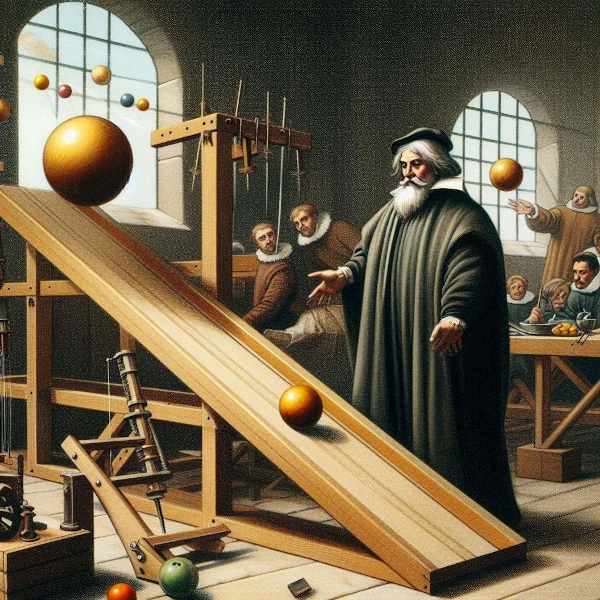
Image description: Representation of Galileo conducting experiments to study the fall of bodies. Image source: astronoo.com
Before Galileo, science was largely dominated by philosophical and theological approaches. Scientific thinking often relied on a priori reasoning and logical speculations, such as those from ancient Greece (Pythagoras (580-495 BC), Plato (428-348 BC), Aristotle (384-322 BC), for example). There was no systematic method to test hypotheses through observation and experimentation.
Before Galileo, the dominant view of the fall of bodies was based on Aristotle's ideas. According to him, heavier objects fell faster than lighter objects. Aristotle postulated that the speed of an object's fall was proportional to its weight, and he also believed that the speed of fall depended on the nature of the object (e.g., stones fell faster than feathers).
With Galileo (1564-1642), the approach to scientific research became based on experimentation, observation, quantification, and mathematical analysis, all key elements of the scientific method as we know it today.
The law of falling bodies, formulated in 1604 by the Italian mathematician, geometer, physicist, and astronomer, represents a fundamental step in understanding the motion of objects under the effect of gravity. Contrary to Aristotle’s view that heavier bodies fell faster than lighter ones, Galileo demonstrated, through experimentation, that all bodies fall at the same rate, regardless of their mass.
Galileo, like many other scientists of his time, observed everyday phenomena, but he was the first to question them in a systematic and experimental way. Galileo noticed that objects of different weights (such as stones of different sizes) seemed to fall at similar speeds, contrary to Aristotle's claim. This did not match the theory that heavier objects fell faster than lighter ones.
Galileo used an inclined plane to slow the fall of objects and allow more precise measurements of the time it took for them to travel a certain distance. The idea was to reduce the speed of fall by spreading it over a longer distance, which allowed him to more easily measure the fall time. Bells were used to mark when the balls reached certain positions on the ramp.
His results, confirmed by his observations, established that the acceleration of a body in free fall is constant and does not depend on its mass or shape.
One of Galileo's innovative ideas was to understand that the acceleration of fall is due to gravitational attraction, and that this acceleration is uniform. Thus, he showed that the distance traveled by an object in free fall is proportional to the square of the fall time. This means that if an object falls twice as long, it will have traveled four times the distance.
The equation was not formulated by Galileo in this precise form, where d is the distance traveled, g is the acceleration due to gravity, and t is the elapsed time.
$$d = \frac{1}{2} g t^2$$
However, he is indeed the origin of the discovery of the relationship between fall time and the distance traveled by an object under the effect of gravity.
By rejecting the idea that the speed of fall depends on the mass of the bodies, he paved the way for a more precise understanding of the motion of celestial bodies and objects on Earth. This law was one of the foundations that later influenced Isaac Newton (1642-1727) in developing his theory of universal gravitation.
The law of falling bodies is one of the first scientific experiments to use rigorous methods of time and distance measurement. It marked a turning point in modern science by introducing basic concepts that are still used today in the study of motion and gravity.